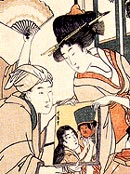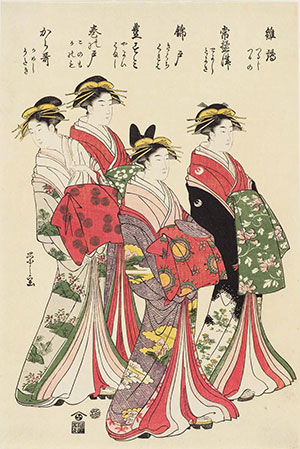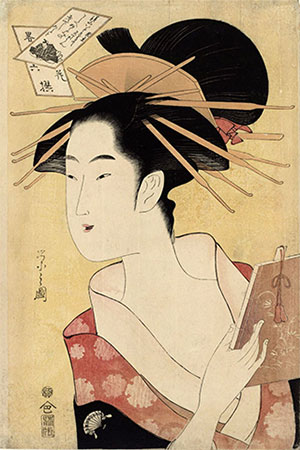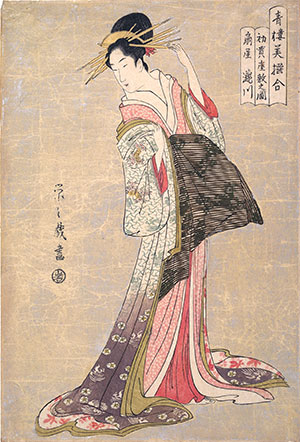

Chôbunsai Eishi (鳥文齋栄之)
|
 Most unusual for an artist of the ukiyo-e school, Chôbunsai Eishi (鳥文齋栄之), 1756-1829, was from a samurai family of the Fujiwara clan — both his grandfather and great grandfather served as kantai bungyô (chief of accounts) for the shogunate, with one of their titles being governor of Tamba province. Thus Eishi was the eldest son of vassal of the shogunate whose surname was Hosoda (細田) and given name Tokitomi (時富). Eishi was also a vassal of the shôgun Tokugawa Ieharu, but in the mid-1780s he was given permission to resign from his duties to pursue a career in art.
Most unusual for an artist of the ukiyo-e school, Chôbunsai Eishi (鳥文齋栄之), 1756-1829, was from a samurai family of the Fujiwara clan — both his grandfather and great grandfather served as kantai bungyô (chief of accounts) for the shogunate, with one of their titles being governor of Tamba province. Thus Eishi was the eldest son of vassal of the shogunate whose surname was Hosoda (細田) and given name Tokitomi (時富). Eishi was also a vassal of the shôgun Tokugawa Ieharu, but in the mid-1780s he was given permission to resign from his duties to pursue a career in art.
Initially, Eishi studied with Kanô Eisen'in Michinobu (1730-90, 狩野英川院典信) who was the chief painter-in-attendance (oku-eishi) to Ieharu. (Eishi also appears to have trained briefly with Torii Bunryûsai, a virtually unknown ukiyo-e artist.) One 19th-century source, the Koga Bikô, records that Eishi was Ieharu's on-ga no tomo ("painting companion"), although he had to retire after three years due to ill health. Eishi's earliest known work in the ukiyo-e (浮世絵) manner appears to have been for a satirical popular illustrated book, a genre called kibyôshi (lit., "yellow covers": 黄表紙) in 1785.
Early on, Eishi specialized in bijinga (pictures of beautiful women: 美人画), among these a number of designs published in series. His work in this genre rivaled that of Torii Kiyonaga (鳥居清長 1752-1815) and Kitagawa Utamaro (喜多川 歌麿 c. 1753-1806).
Although in the beginning Eishi portrayed courtesans in a manner reminiscent of Kiyonaga, they were rendered with an idiosyncratic refinement that distinguished them from Kiyonaga's beauties. In discussions about Eishi, one often hears descriptive terms such as "elegant," "graceful," or "patrician." One example from circa early 1790s depicts four courtesans from the Chôjiya (丁子屋) brothel arrayed in elegant robes as they promenade in the Yoshiwara pleasure quarter. Interestingly, six beauties are named on the sheet, along with the names of two kamuro (child attendants: 禿) for each high-ranking courtesan. Perhaps there might have been a companion sheet with two other pleasure women portrayed, but at the moment this has not been verified. Moreover, other sheets by Eishi are known with more inscribed names than the number of courtesans portrayed, so this might simply have been an affectation for this type of design whereby a one-to-one correspondence between names and figures was not necessarily of concern to the publisher, artist, or brothels (if the latter sponsored the production of particular prints). Although this type of stately arrangement of female beauties can be found in the works of Kiyonaga, the rendering of the faces is a bit more ethereal than those found in Torii master.
 In addiiton to Eishi's bijinga depicting women going about their daily activities, he and other ukiyo-e artists sometimes reworked courtly and classical themes into his designs (see image on the right). He did very few ôban-size ôkubi-e ("large-head pictures"; or bust portraits: 大首絵), but one print that typifies his style in the mid-1790s and his allusions to classical topics depicts the courtesan Kuronushi (黒主) for a circa 1796 series titled Yatsushi Rokkasen (Six selected flowers: 略六花撰), actually a parody or analogue of the Six Immortal Poets (Rokkasen: 六歌仙). The Rokkasen were celebrated poets of the ninth century whose names were first linked together in the poetic anthology Kokin wakashû (Collection of ancient and modern poems: 古今集) in 905 AD. They were the subject of numerous ukiyo-e prints of various types, among them mitate-e (analogue or likening pictures: 見立絵) in which the Rokkasen were associated with modern-day figures (frequently fashionable beauties, courtesans, or dandies of the pleasure quarters). In this example, Kuronushi stands apart from the contemporaneous beauties drawn by Utamaro. There is a sweetness about her that we now associate with the Eishi style, with her slim face and long neck and nearly straight nose.
In addiiton to Eishi's bijinga depicting women going about their daily activities, he and other ukiyo-e artists sometimes reworked courtly and classical themes into his designs (see image on the right). He did very few ôban-size ôkubi-e ("large-head pictures"; or bust portraits: 大首絵), but one print that typifies his style in the mid-1790s and his allusions to classical topics depicts the courtesan Kuronushi (黒主) for a circa 1796 series titled Yatsushi Rokkasen (Six selected flowers: 略六花撰), actually a parody or analogue of the Six Immortal Poets (Rokkasen: 六歌仙). The Rokkasen were celebrated poets of the ninth century whose names were first linked together in the poetic anthology Kokin wakashû (Collection of ancient and modern poems: 古今集) in 905 AD. They were the subject of numerous ukiyo-e prints of various types, among them mitate-e (analogue or likening pictures: 見立絵) in which the Rokkasen were associated with modern-day figures (frequently fashionable beauties, courtesans, or dandies of the pleasure quarters). In this example, Kuronushi stands apart from the contemporaneous beauties drawn by Utamaro. There is a sweetness about her that we now associate with the Eishi style, with her slim face and long neck and nearly straight nose.
Eishi also produced exceedingly slender beauties whose heads were sometimes a mere 10 percent of the total height of the figures, matching Kiyonaga in this type of elongated female form. A fine example from circa 1794-95 is shown below — a portrayal of Takigawa (滝川) of the Ôgiya (扇屋) brothel in the Yoshiwara (葭原 then later 吉原). The print is subtitled (in the middle cartouche) Hatsu-uri zashiki no zu (View of the first reception-room appointment of the New Year: 初売座敷之図). It is a design from the series Seirô bisen awase (Comparison of selected beauties of the pleasure quarters: 青楼美撰合).
 Eishi has depicted the high-ranking courtesan Takigawa as she adjusts her hair and clothing in preparation for receiving a customer. Such refined raiment would have adorned the bodies of only the most sought-after and expensive courtesans. Eishi's impossibly tall and slim typology of beauty seems to endow such rarified pleasure women with a mythical form that reflects their exalted status. Even the mica background, despite its wear and tear, enhances the air of sophistication surrounding Takigawa and the role she played in her profession. There is no suggestion of the reality of her servitude; only a fantasy for the male (and female) gaze is presented.
Eishi has depicted the high-ranking courtesan Takigawa as she adjusts her hair and clothing in preparation for receiving a customer. Such refined raiment would have adorned the bodies of only the most sought-after and expensive courtesans. Eishi's impossibly tall and slim typology of beauty seems to endow such rarified pleasure women with a mythical form that reflects their exalted status. Even the mica background, despite its wear and tear, enhances the air of sophistication surrounding Takigawa and the role she played in her profession. There is no suggestion of the reality of her servitude; only a fantasy for the male (and female) gaze is presented.
Beyond what has been said above, Eishi also made occasional illustrations forwoodblock-printed books, including shunga ("spring pictures" or erotica: 春画). However, of greater note,.
It appears that around the early to mid-1780s Eishi abandoned print design to devote himself entirely to painting. He was a prolific painter of such impressive talent that in 1800(?) one of his paintings, Sumidagawa (The Sumida River: 隅田川), entered the collection of the cloistered Empress Go-Sakuramachi (後桜町天皇 1740-1813) and he was granted the honorary title Jibukyô (High Official of the Ministry of Ceremony": 治部卿). Somewhere between 200 to 300 extant paintings are assigned to Eishi, spanning, at least, the years 1795 to 1826. He reprised some of his painting subjects, either in formal or casual styles, and today many of these replicated versions are considered genuine Eishi re-creations.
Eishi not only painted subjects popular in ukiyo-e, but also handscrolls of military scenes such as the Sekigahara no tatakai (Battle of Sekigahara: 關ヶ原の戰い) or comic scrolls (including one based on the gods of good fortune visiting the Yoshiwara, the idea taken from an essay of 1781 titled Kakure-zato no ki(Record of them hidden village: かくれ里の記) by the floating-world writer Ôta Nanpo (大田 南畝 1749-1823). Other painting genres included seibutsu-ga (still life: 静物画), fûkeiga (landscapes: 風景画), and kachôga (nature or bird-flower pictures: 花鳥画). Paintings are known in which Eishi combined subdued ink-wash Kanô-style backgrounds, landscapes, or figures with ukiyo-e figures rendered with chromatic potency. All-told, Eshi's boy of work is one of the crowing achivements of the ukiyo-e school. © 2001-2019 by John Fiorillo
BIBLIOGRAPHY
- Clark, T., "Mitate-e: Some thoughts, and a summary of recent writings," in: Impressions, New York 1997, no. 19, pp. 7-27.
- Clark, T., Ukiyo-e Paintings in the British Museum. London: British Museum Press, 1992. p. 122-131, nos. 72-80.
- Konishi, J., "Fûryû: An ideal of Japanese esthetic life," in: M. Schneps and A. Coox (eds.), The Japanese image. Tokyo/Philadelphia 1965, pp. 271-278.
Viewing Japanese Prints |